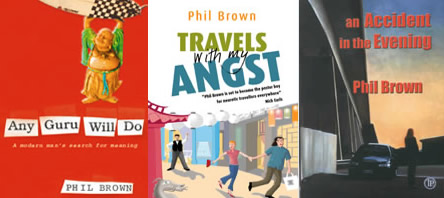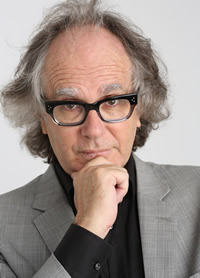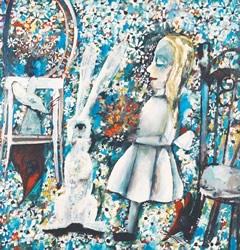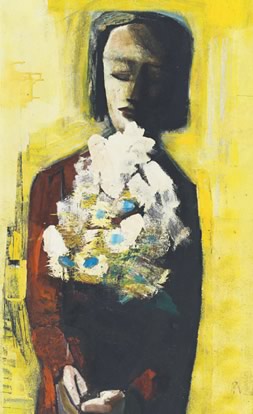
Phil Brown
journalist . writer . poet
articles . books . poems
Phil Brown - Art Column
BLACKMAN IN SUNSHINE
A Charles Blackman exhibition explores the artist’s Queensland connections and the influence of his first wife, Barbara, a girl from the ’burbs of Brisbane, writes Phil Brown
It's ironic that the woman who inspired artist Charles Blackman's most famous works has never seen them. Blackman's first wife, Barbara (formerly Barbara Patterson), the girl from Indooroopilly who Blackman fell in love with when they were both only 20, was the muse for his famous Alice series.
One of the treasures in Lure of the Sun: Charles Blackman in Queensland, which opens at Queensland Art Gallery next weekend, is The Blue Alice painted between 1956 and 1957. (The exhibition features more than 50 paintings and works on paper from private and state collections.)
Barbara Blackman, who went blind as a young woman and was married to the artist for 30 years, served as the model for his paintings based on Lewis Carroll's Alice's Adventures in Wonderland. Charles Blackman was introduced to the story when Barbara brought home a talking book machine and the couple listened to it together.
"Alice brought some order into the chaos of Wonderland and I brought order into the world of Charles," Blackman recalls. "He said he wouldn't have been a painter without the order I gave his life and the Alice paintings were a reflection of that. But of course I have never seen them because I can't see."
Barbara, who is an author, librettist and patron of the arts, is now 86 and living in Canberra. She and Charles Blackman (he has been married three times, she has been married twice) had three children. They wrote books together and Barbara is still writing and has a collection of essays being published by UQP next year. The Blackmans lived mostly in Melbourne, also in London for a time and on and off in Brisbane for many years. They met here. Barbara, who went to Brisbane State High School then the University of Queens land. int roduc ed Charles to local artists and poets and he went on to exhibit here regularly at the Johnstone Gallery in Bowen Hills.
Betty Churcher identified Barbara as the inspiration for Alice in her book Australian Notebooks. She wrote that Blackman creates a "topsyturvy" world where one can easily become enchanted and disoriented - but not Alice. She resides in her own interior world. Her eyes are calm, if sightless, and she retains her perfect common sense in all situations, unfazed by a world in chaos about her. The painting is really a hymn to Barbara Blackman, the artist's wife, who copes with life without the benefit of sight.
Barbara has lived a long and productive life and still speaks fondly of her former husband, but says she was devastated by his alcoholism, the cause of their divorce. Charles Blackman is still alive but in care due to his infirmity.
He is considered one of our greatest artists and there have been retrospectives of his work, but this is the first to concentrate on his strong connection to Queensland.
Blackman has said that "Queensland had the best influence on me as a person, its sunshine and its lightness of colour and its friendly spirit probably helped me to flower as a personality in some way".
The works in this show exemplify that and Michael Hawker, associate curator Australian art at QAGOMA, stresses that it was coming to Brisbane and meeting Barbara that changed everything for Charles Blackman.
"It was during his first visit to Brisbane in 1948 that the artist experienced the sense of intense personal discovery that was to launch his career trajectory, having found love and the means of artistic expression articulated through a strong and unique visual vocabulary focused on an inner psychological reality," Hawker writes. "Later, in the early 1980s, he settled at Buderim on the Sunshine Coast seeking to energise and renew his art through a series of new collaborative projects exploring the natural environment."
There are some fascinating Queensland paintings in this exhibition including the rather gloomy 1951 painting Self-portrait in front of a boarding house, Spring Hill.
Charles Blackman was torn between Melbourne and Brisbane after meeting Barbara and before the Alice series, which developed early in their married life, there was the Schoolgirl series. Michael Hawker points out that this one, which is also represented in the show, also had a Brisbane connection. "These dark and sometimes menacing images were influenced by the shocking murder of a schoolgirl in Melbourne, as well as the unsolved Brisbane murder in 1952 of Betty Shanks, a university friend of Barbara Blackman."
Hawker says some people will be surprised by Brisbane's influence on Charles Blackman and how much time he spent here. The couple wintered in Brisbane and owned a house at St Lucia for a time.
"And there were a lot of creative friendships forged in Queensland," Hawker says. Blackman was friendly with other painters including Roy and Betty Churcher, the poet Judith Wright and her husband Jack. Blackman also fell in with the Bohemian painter Jon Molvig. Barbara Blackman recalls that Molvig co-opted Blackman to help him teach art classes on the Gold Coast.
"Jon Molvig got to teach all the attractive young women and Charles got the retirees," she wryly recalls.
The iconic Alice series was created in Melbourne and Brisbane between 1955 and 1957. The Blue Alice, purchased for the QAGOMA collection in 2000, was the first painting of the series and is very special. There were 57 Alice pictures in all and Churcher describes them as examples of "Blackman at his lyrical best", inspired, as it happens, by a lass from Indooroopilly.
SEE IT
LURE OF THE SUN: CHARLES
BLACKMAN IN QUEENSLAND
Where: Glencore Queensland Artist's Gallery, Queensland Art Gallery, South Bank
When: November 7- January 31
Cost: Free entry
More info: qagoma.qld.gov.au



